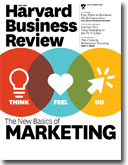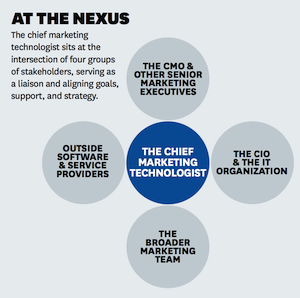When I first started writing about the role of a chief marketing technologist in 2008, it was, at best, a niche subject. A hybrid marketing and technology executive? What kind of crazy, chimerical beast was that?
But six years later, with marketing increasingly viewed as a technology-powered discipline, hybrid marketing technologist roles are growing rapidly. Reviewing registrations for the upcoming MarTech Conference, it’s incredible to see so many leading companies with official heads of marketing technology now.
This week, these roles are also being recognized at the highest levels of management and business leadership. The July-August issue of Harvard Business Review was just released with spotlight focus is on “the new marketing organization.” And I’m delighted and honored that one of their spotlight’s featured articles is The Rise of the Chief Marketing Technologist, co-authored by Laura McLellan and myself.
It describes the basic framework of the role and the forces that are motivating the establishment of these positions, and it also provides short vignettes of five real-world marketing technologists.
The article begins:
Marketing is rapidly becoming one of the most technology dependent functions in business. In 2012 the research and consulting firm Gartner predicted that by 2017, a company’s chief marketing officer would be spending more on technology than its chief information officer was. That oft-quoted claim seems more credible every day.
A new type of executive is emerging at the center of the transformation: the chief marketing technologist. CMTs are part strategist, part creative director, part technology leader, and part teacher. Although they have an array of titles — Kimberly-Clark as a “global head of marketing technology,” while SAP has a “business information officer for global marketing,” for example — they have a common job: aligning marketing technology with business goals, serving as a liaison to IT, and evaluating and choosing technology providers. About half are charged with helping craft new business models as well.
Regardless of what they’re called, the best CMTs set a technology vision for marketing. They champion greater experimentation and more-agile management of that function’s capabilities. And they are change agents, working within the function and across the company to create competitive advantage.
The five marketing technologists who are featured in the article are:
- Mayur Gupta, Global Head of Marketing Technology and Operations at Kimberly-Clark — one of the leading champions for this role, who will be our featured opening speaker at MarTech, giving a talk on Growing Business with Marketing Technology: From Operations to Innovation (he’s also on the conference’s board of advisors). You can also read a Q&A I did with Mayur last year, balancing marketing technology and IT at a Fortune 500 firm.
- Joseph Kurian, Head of Marketing Technology and Innovation for Enterprise Marketing at Aetna.
- Andreas Starke, the Business Information Officer for Global Marketing at SAP. You can a read a Q&A I did with Andreas earlier this year, 6 questions with SAP’s chief marketing technologist.
- Brian Makas, Director of Marketing Technology and Business Intelligence at ThomasNet. You can read a Q&A I did with Brian a few years ago, marketing technology at a 113-year-old firm.
- Shawn Goodin, Director of Marketing Technology at The Clorox Company, who will also be presenting at MarTech on Marketing Technologist as Marketing Transformation Sherpa.
It’s wonderful to see these pioneers in the field receive some recognition in such a premier publication for the work they’re doing. Laura and I both really appreciate them agreeing to be included in the article.
By the way, on the topic of chief marketing technologists, here’s one more reason to come to MarTech: my co-author of this piece, Laura McLellan, will be presenting her groundbreaking research at Gartner in a talk Chief Marketing Technologists Symbolize Marketing’s Changing Role.
As she describes it: “The best chief marketing technologists accelerate the shift from traditional governance, sourcing, and risk management to agile processes, a results mindset, and a culture of innovation. This presentation distills the most critical trends and ramifications.”
If you’re a marketing technologist — or you work with them in your role as a marketing leader — you won’t want to miss this opportunity to hear from some of the stars in our field and network with several hundred of your peers. Register now!






Congratulations, Scott! Will be sure to pick up this issue.
Thanks, Clare! Just HBR following the editorial lead of Chief Content Officer from 3 (!) years ago. 🙂
Congratulations Scott! Well deserved – remember the little people 🙂
Thanks, Siobhan — I greatly appreciate all the support!
Hi Scott,
Great that HBR have found the wagon!.
I would love to come to Martech, I spent a wonderful year in Boston (1974, so long ago) as a very young marketer finding my feet, but it is such a long way from Sydney!!
Cheers
Allen
Thanks, Allen. Hopefully we’ll have a MarTech Australia someday!
Great to see more analysis around the rise in importance of all tools digital. The idea of a ‘chief marketing technologist’ begs the question– how is this role different from/similar to a Chief Digital Officer?
There’s certainly the potential for overlap, depending on how you define the roles (and there are a lot of variations in the definition). To me, a CDO is more of a business officer — defining how the company is pursuing digital business overall — while the CMT is a little more technical, more like a CTO for marketing.